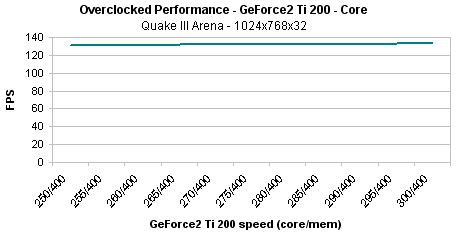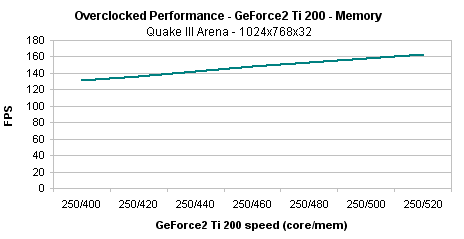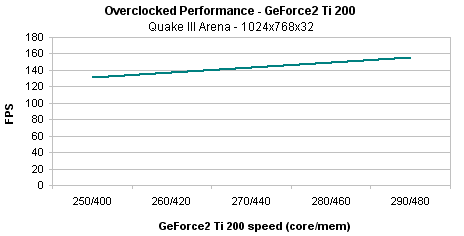NVIDIA GeForce2/3 Titanium Roundup - January 2002
by Matthew Witheiler on January 30, 2002 9:33 PM EST- Posted in
- GPUs
Overclocking the GeForce2 Ti 200
Like the other Titanium series, the GeForce2 Ti 200 received an altered clock speed in order to gain the Titanium badge. Unlike the GeForce3 Titanium cards, however, the GeForce2 Ti 200 got more than just a speed modification
In addition to gaining 50MHz on the core speed compared to its GeForce2 Pro predecessor, the GeForce2 Ti 200 also got a die shrink. The GeForce2 Ti 200 is essentially a GeForce2 GTS series chip that is manufactured on a 0.15 micron process instead of the older 0.18 micron process used in GeForce2 GTS, GeForce2 Pro, and GeForce2 Ultra chips. This allowed NVIDIA to reach higher clock speeds with better yields on the GeForce2 Ti 200 cores.
As a result of the smaller process, we were curious to see how the GeForce2 Ti 200 responded to overclocking. We suspected that the GeForce2 Ti 200 would be an eager overclocker. Let's see how it did when we boosted up the core speed. We used the Gainward GeForce2 Ti/450 in this instance, as it was able to reach the highest clock speeds during our tests.

Looking at the performance increase that resulted from the core speed overclock, we can deduce that there is a memory bandwidth bottleneck in the GeForce2 Ti 200's 400MHz DDR memory bus. Increasing the core clock speed from the stock 250MHz to 300MHz resulted in a performance gain of only 1.6%, representing a 2.1 FPS speed boost. If the GeForce2 Ti 200 had the same memory management technologies incorporated in the GeForce3 series cards and featured a higher memory clock speed, we could have expected a much larger performance boost associated with the 50MHz overclock.
The small performance gain that occurred when overclocking the GeForce2 Ti 200 core alone is modeled by the regression line f(x)=0.042x+131.014. As you can see, the extremely small slope suggests that performance increases only very marginally each time the core clock speed is boosted up 1MHz.
Knowing that the card appears to be quite memory bandwidth limited at the stock clock setup, we suspected that a memory overclock would dramatically increase the card's performance. Let's see what it did to the performance of the card.

The line increases at a much greater rate when the memory clock is upped while maintaining the stock core speed. No longer are we looking at marginal gains from overclocking like we saw when we overclocked the core. Instead, the performance of our GeForce2 Ti 200 increased 24.8% when overclocked; a very noticeable speed boost that provided for an additional 32.4FPS in Quake III Arena at 1024x768x32.
The data in this case increases in an almost perfect linear fashion, suggesting that the memory bus is the bottleneck in the GeForce2 Ti 200. The regression line, f(x)=0.271x+131.279, shows that it took approximately 3MHz of overclocking to increase gameplay performance by 1FPS in our test.

Once again, we were able to realize rather large speed increases when overclocking both the memory and the core of the GeForce2 Ti 200. Overclocking the card to the max speed we could reach while pushing both the memory and core was 290MHz/480MHz. Note that this is a lower speed than we were able to get when overclocking just the memory or just the core, as card speeds were 300MHz/400MHz when overclocking just the core and 250MHz/520MHz when overclocking just the memory. At 290MHz/480MHz the GeForce2 Ti 200 performed 18.6% better than the stock clocked card, increasing gameplay by 24.3FPS.
The regression line for this data fits a linear model represented by f(x)=0.611x+131.02. As you can see, the slope of this line is the largest yet, meaning that for each 1MHz that the core clock was increased and 2MHz that the memory clock was increased, game performance increased the most. It took only 2 steps (2MHz on the core and 4MHz on the memory) to get to a 1FPS speed increase.
It is important to note that just because the slope of the line produced when overclocking the core and the memory was the largest, overclocking the core and the memory in this case did not necessarily produce the most performance. This is because when we overclocked the core and the memory together we could not get the same high clock speeds that we got when overclocking just the core or just the memory (as noted above).
Because of this, we were actually able to get the most performance out of our GeForce2 Ti 200 card by overclocking the memory alone. Pushing the memory clock to 520MHz resulted in better performance than pushing the core to 290MHz and the memory clock to 480MHz. This is because, as we noted before, the GeForce2 Ti 200's memory bus is the bottleneck in the system
As the data shows, the best way to overclock your GeForce2 Ti 200 is to push the memory as high as possible and then slowly bring up the clock speed.










0 Comments
View All Comments